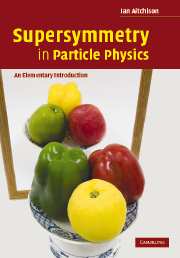Book contents
- Frontmatter
- Contents
- Preface
- Acknowledgements
- 1 Introduction and motivation
- 2 Spinors: Weyl, Dirac and Majorana
- 3 Introduction to supersymmetry and the MSSM
- 4 The supersymmetry algebra and supermultiplets
- 5 The Wess–Zumino model
- 6 Superfields
- 7 Vector (or gauge) supermultiplets
- 8 The MSSM
- 9 SUSY breaking
- 10 The Higgs sector and electroweak symmetry breaking in the MSSM
- 11 Sparticle masses in the MSSM
- 12 Some simple tree-level calculations in the MSSM
- References
- Index
9 - SUSY breaking
Published online by Cambridge University Press: 05 September 2012
- Frontmatter
- Contents
- Preface
- Acknowledgements
- 1 Introduction and motivation
- 2 Spinors: Weyl, Dirac and Majorana
- 3 Introduction to supersymmetry and the MSSM
- 4 The supersymmetry algebra and supermultiplets
- 5 The Wess–Zumino model
- 6 Superfields
- 7 Vector (or gauge) supermultiplets
- 8 The MSSM
- 9 SUSY breaking
- 10 The Higgs sector and electroweak symmetry breaking in the MSSM
- 11 Sparticle masses in the MSSM
- 12 Some simple tree-level calculations in the MSSM
- References
- Index
Summary
Since SUSY is manifestly not an exact symmetry of the known particle spectrum, the issue of SUSY breaking must be addressed before the MSSM can be applied phenomenologically. We know only two ways in which a symmetry can be broken: either (a) by explicit symmetry-breaking terms in the Lagrangian, or (b) by spontaneous symmetry breaking, such as occurs in the case of the chiral symmetry of QCD, and is hypothesized to occur for the electroweak symmetry of the SM via the Higgs mechanism. In the electroweak case, the introduction of explicit symmetry-breaking (gauge non-invariant) mass terms for the fermions and massive gauge bosons would spoil renormalizability, which is why in this case spontaneous symmetry breaking (which preserves renormalizability) is preferred theoretically – and indeed is strongly indicated by experiment, via the precision measurement of finite radiative corrections. We shall give a brief introduction to spontaneous SUSY breaking, since it presents some novel features as compared, say, to the more ‘standard’ examples of the spontaneous breaking of chiral symmetry in QCD, and of gauge symmetry in the electroweak theory. But in fact there is no consensus on how ‘best’ to break SUSY spontaneously, and in practice one is reduced to introducing explicit SUSY-breaking terms as in approach (a) after all, which parametrize the low-energy effects of the unknown breaking mechanism presumed (usually) to operate at some high mass scale. We shall see in Section 9.2 that these SUSY-breaking terms (which are gauge invariant and super-renormalizable) are quite constrained by the requirement that they do not re-introduce quadratic divergences which would spoil the SUSY solution to the SM fine-tuning problem of Section 1.1; nevertheless, over 100 parameters are needed to characterize them.
- Type
- Chapter
- Information
- Supersymmetry in Particle PhysicsAn Elementary Introduction, pp. 137 - 153Publisher: Cambridge University PressPrint publication year: 2007

